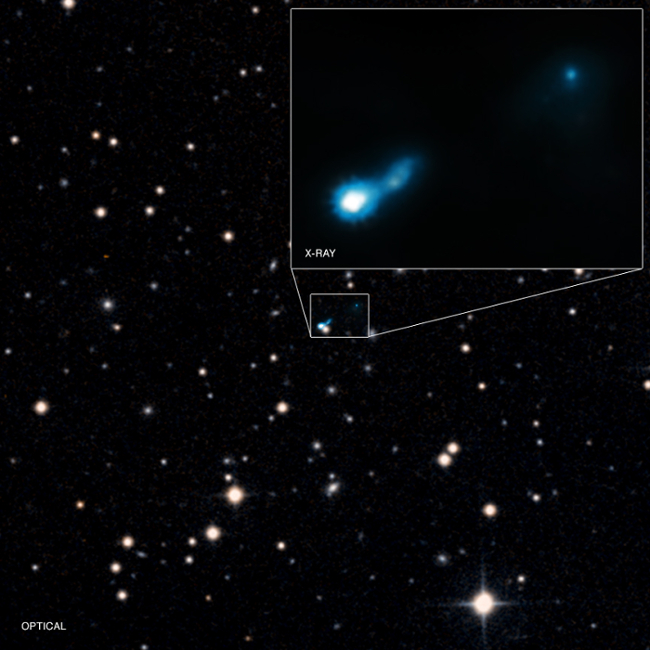
 Credit: X-ray: NASA/CXC/ISAS/A.Simionescu et al, Optical: DSS
Credit: X-ray: NASA/CXC/ISAS/A.Simionescu et al, Optical: DSS
An Ancient Jet
We know that nearly every galaxy hosts a central, supermassive black hole. No one really knows how these monsters formed, or how they evolve with time. Supermassive black holes can actively swallow enormous amounts of material from their host galaxies, and this accretion of matter powers intense high-energy radiation and can produce powerful jets of charged particles that shoot from the black hole for hundreds of thousands of lightyears. These jets usually produce strong emission at radio wavelengths, and sometimes even high-energy X-ray emission as well. A recent Chandra X-ray Observatory X-ray image of a distant galaxy cluster called Abell 585 led to an unexpected, important discovery. The Chandra observation, pictured above in blue (and superimposed on an optical image of the cluster), shows an X-ray emitting jet from a black hole in one of the cluster galaxies. Astronomers think that the X-ray emission is actually lower-energy radiation from the Big Bang that has been boosted into the X-ray band after colliding with the high energy, high speed particles in the galactic jet. This surprise discovery is one of the few detections of an X-ray emitting galactic jet in the distant Universe. This observation provides an important clue to the history of supermassive black hole formation in the Universe, and indicates that an actively feeding central supermassive black hole already existed only a few billion years after the Big Bang.
Published: March 7, 2016
<
HEA Dictionary ● Archive
● Search HEAPOW
● Other Languages
● HEAPOW on Facebook
● Download all Images
● Education ● HEAD
>

Each week the HEASARC
brings you new, exciting and beautiful images from X-ray and Gamma ray
astronomy. Check back each week and be sure to check out the HEAPOW archive!
Page Author: Dr. Michael F. Corcoran
Last modified Monday, 26-Feb-2024 17:09:51 EST


